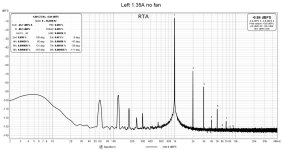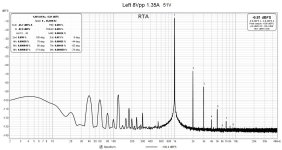Hello,
I built the F5m amp with Nelson Pass PSU. I would like to add a small microcontroller inside the chassis to allow me to control the front panel LED(s). My board would draw under 200mA and the voltage regulator input has a max of 36V.
The Nelson Pass has +-24V rails fed from the transformer sourced diode rectifier bridges(2). Can I tap into the GND and +24V rail on the PSU board to supply my microcontroller voltage regulator or will that potentially cause a negative side effects on the F5m circuit/audio? My board would power a couple of LEDs at 20mA each or so and it will be using PWM so I don't want that interfering with the audio.
Thank you
I built the F5m amp with Nelson Pass PSU. I would like to add a small microcontroller inside the chassis to allow me to control the front panel LED(s). My board would draw under 200mA and the voltage regulator input has a max of 36V.
The Nelson Pass has +-24V rails fed from the transformer sourced diode rectifier bridges(2). Can I tap into the GND and +24V rail on the PSU board to supply my microcontroller voltage regulator or will that potentially cause a negative side effects on the F5m circuit/audio? My board would power a couple of LEDs at 20mA each or so and it will be using PWM so I don't want that interfering with the audio.
Thank you
so I don't want that interfering with the audio.
if you're sure, here's your answer
I'm not sure. Has anyone else used a microcontroller in an amp project? If so, I'm curious to find out what was used as its power source. ( tap into the main transformer, or add a second transformer? )
If you have the components already you can connect them up and see and hear if there are any issues.
It's DIY! 🤓
It's DIY! 🤓
If I connect the channel outputs to 2 channels on my oScope, do I risk blowing or damaging the amp? I could send a clean wave and see if it's clean maybe? Not sure my ears are sensitive enough to detect noise. ( age son )
I'm thinking the large caps and filter resistors on the PSU will already be smoothing out noise so I could just tap in to the +24V without bothering the audio power. It should be ok but I'm still learning about audio and thought I could confirm this with an expert.
I'm thinking the large caps and filter resistors on the PSU will already be smoothing out noise so I could just tap in to the +24V without bothering the audio power. It should be ok but I'm still learning about audio and thought I could confirm this with an expert.
Last edited:
I use my REW/Focusrite FFT rig to check noise.
For ultrasonic noise an oscilloscope may be better.
To check the amplifier output you should have a load (8R high wattage resistor) attached to the output.
Be sure that the oscilloscope ground is connected the Ground on the amplifier.
There is probably more danger to the oscilloscope than to the amplifier.
For ultrasonic noise an oscilloscope may be better.
To check the amplifier output you should have a load (8R high wattage resistor) attached to the output.
Be sure that the oscilloscope ground is connected the Ground on the amplifier.
There is probably more danger to the oscilloscope than to the amplifier.
Last edited:
I have designed many audio projects with PIC microcontrollers in them.I'm not sure. Has anyone else used a microcontroller in an amp project? If so, I'm curious to find out what was used as its power source. ( tap into the main transformer, or add a second transformer? )
I usually drop the voltage using 5W zeners and then into a 5 volt regulator.
Never had a problem with interference.
@nigelwright7557 Good to know. Do you use a 100ohm resistor in series with the +24V with a 15V zener to GND before the load?
For 24 volts I would just use a 5 volt regulator.
But you will need a heat sink for 200mA.
Another option is to use a 12 volt 5W zener in series from 24 volts to drop a few volts so there is less across the regulator.
But you will need a heat sink for 200mA.
Another option is to use a 12 volt 5W zener in series from 24 volts to drop a few volts so there is less across the regulator.
I'll drop the +24V down using a 12V 5W zener in serial with no resistor as you suggest. I currently use VXO7803-500-M as a voltage regulator with +12V in ( for Eurorack ) and it does not run hot at all I don't think. I must be drawing much less than 200mA.
Thanks
Thanks
I have not tapped off the amp power supply for a microprocessor, but I have powered a low voltage cooling fan. I was not able to get rid of all the added noise, which showed up as 40 Hz and its harmonics.
In the end, I just lived with it. I didn't really notice it, and I didn't want to add a separate power supply.
In the end, I just lived with it. I didn't really notice it, and I didn't want to add a separate power supply.
Attachments
That is FFT analysis with REW (Room Equalization Wizard) software and a USB sound card such as a Focusrite
.How to - Distortion Measurements with REW
.How to - Distortion Measurements with REW
@nigelwright7557 I'm curious to find out what you use for soft switch? May as well implement that at this time too. ( eg. turn off soft switch after 6 hours or something like that since I'm sure I'll forget and leave it on )
@nigelwright7557 True. I'm using STM32 uCs. Do you use a preferred MOSFET/Transistor circuit for the soft switch? I know there are several approaches. I have the +-24 rails to disable at the same time I guess. First attempt at this amp soft switch 😉
- Home
- Amplifiers
- Pass Labs
- Powering a Microcontroller from Nelson Pass PSU

